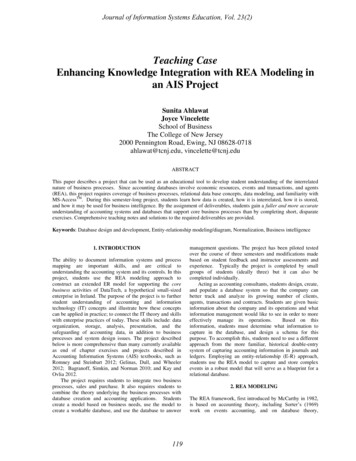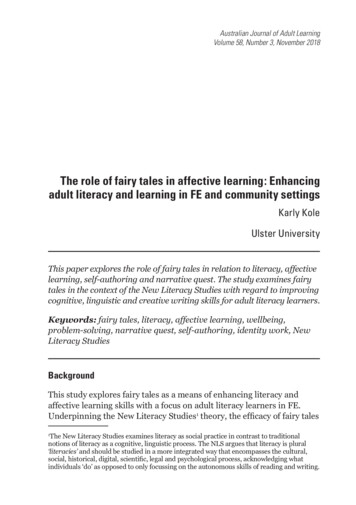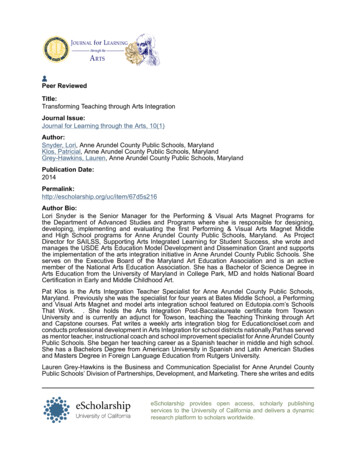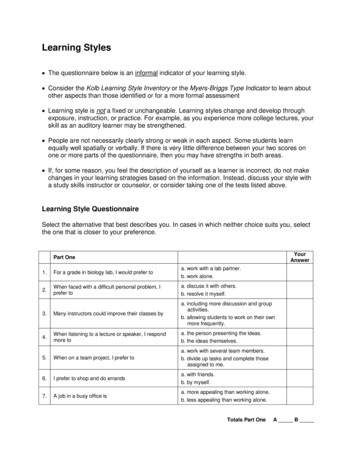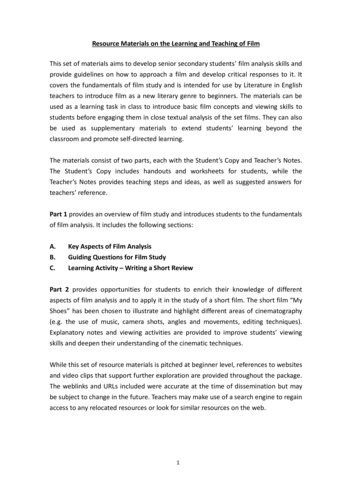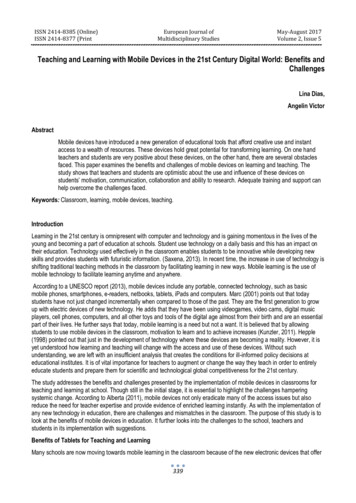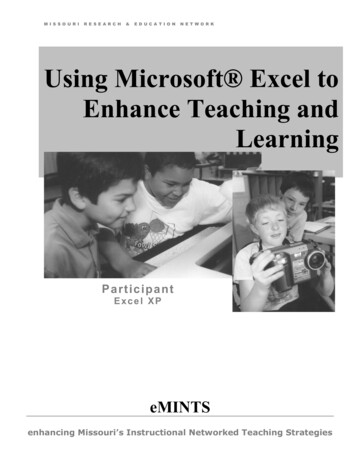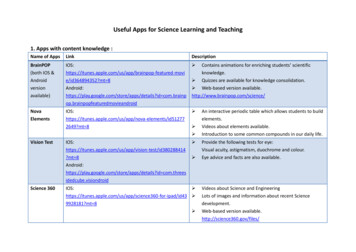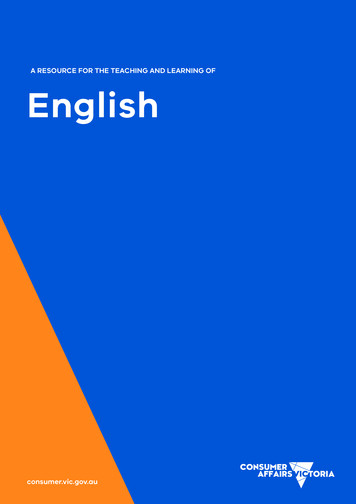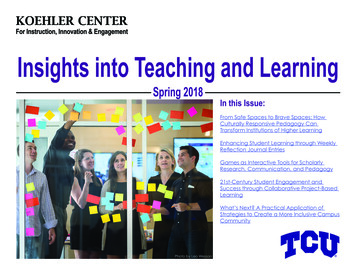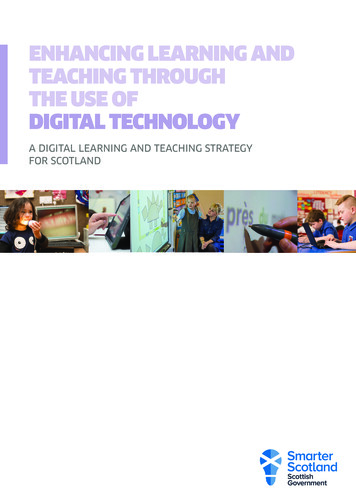
Transcription
ENHANCING LEARNING ANDTEACHING THROUGHTHE USE OFDIGITAL TECHNOLOGYA DIGITAL LEARNING AND TEACHING STRATEGYFOR SCOTLAND
ENHANCING LEARNING ANDTEACHING THROUGHTHE USE OFDIGITAL TECHNOLOGYA DIGITAL LEARNING AND TEACHING STRATEGYFOR SCOTLANDEdinburgh 2016
Crown copyright 2016This publication is licensed under the terms of the Open Government Licence v3.0 exceptwhere otherwise stated. To view this licence, visit /version/3 or write to the Information Policy Team, The NationalArchives, Kew, London TW9 4DU, or email: psi@nationalarchives.gsi.gov.uk.Where we have identified any third party copyright information you will need toobtain permission from the copyright holders concerned.This publication is available at www.gov.scotAny enquiries regarding this publication should be sent to us atThe Scottish GovernmentSt Andrew’s HouseEdinburghEH1 3DGFirst published by The Scottish Government, September 2016ISBN: 978-1-78652-473-7 (Web only)Published by The Scottish Government, September2016Produced for The Scottish Government by APS Group Scotland, 21 Tennant Street, Edinburgh EH6 5NAPPDAS79264 (09/16)
ENHANCING LEARNING AND TEACHING THROUGH THE USE OF DIGITAL TECHNOLOGY 1A MESSAGE FROM THE DEPUTY FIRST MINISTER ANDCABINET SECRETARY FOR EDUCATION AND SKILLSDelivering excellence and equity in Scottish education is my clear focus asCabinet Secretary for Education and Skills. I am committed to ensuring thatwe do everything we can to raise levels of attainment, close the povertyrelated attainment gap and improve the life chances of all our children andyoung people.Digital technology can make a significant contribution. Where our educatorsare supported through professional development, resources and leadership,digital technology can enrich learning and teaching, help to raise levels of attainment andclose the attainment gap. The skilful deployment of digital technology in our schools andearly learning settings will also ensure our learners develop a level of general and specialistdigital skills that are so vital for learning, life and work in an increasingly digitised world.I want to unlock this potential – to the benefit of the individuals, Scottish economy andsociety as a whole.The positive impact of digital technology is already felt within schools across Scotland.There are fantastic examples of innovative practice across all areas of Curriculum forExcellence. However, there is more to do to ensure that all our children and young peoplecan benefit in this way.The strategy sets out a comprehensive approach to deliver the increased effective use ofdigital technology in education and bring about the equity of opportunity that is the keyfocus for this government. It is structured around four key areas: the skills of our educators;access to technology; curriculum and assessment; and leadership.In setting out a clear vision and action plan, this strategy will also clarify expectationsaround the use of digital technology in education. This forms part of my broadercommitment to streamline guidance and minimise bureaucracy for education practitionersin Scotland.The strategy also aligns with our approach to cyber resilience1, recognising the importanceof ensuring that young people and schools capitalise on the benefits of using digitaltechnology safely.Of course, the successful delivery of this strategy requires a co-ordinated effort at alllevels of the system. This strategy sets out a number of actions at a national level andexpectations for local authorities and education establishments, implementation of whichwill be taken forward in line with the conclusions of the Scottish Government’s EducationGovernance Review.It is only by working together that we can realise the potential of digital technology for allof our children and young people.John SwinneyDeputy First Minister andCabinet Secretary for Education and SkillsSeptember 20161 Safe, Secure & Prosperous: a Cyber Resilience Strategy for Scotland (November 2015)
2 ENHANCING LEARNING AND TEACHING THROUGH THE USE OF DIGITAL TECHNOLOGYCONTENTSINTRODUCTION3EDUCATIONAL VALUE FROM DIGITAL TECHNOLOGY1) Enhancing Learning and Teaching2) Improving Educational Outcomes3) Building Digital Skills881112ACHIEVING OUR VISION13Achieving the Objectives14Objective 1: Develop the skills and confidence of educators in the appropriateand effective use of digital technology to support learning and teaching15Objective 2: Improve access to digital technology for all learners19Objective 3: Ensure that digital technology is a central consideration in all areas ofcurriculum and assessment delivery24Objective 4: Empower leaders of change to drive innovation and investment indigital technology for learning and teaching28IMPLEMENTATION OF ACTION PLANS31MEASURING SUCCESS32ANNEXES33Annex A – Glossary of Digital Terms33Annex B – Strategic Principles34Annex C – The Broader Policy Landscape35Annex D – Strategy Development Process37Annex E – The Digital Skills Agenda38
ENHANCING LEARNING AND TEACHING THROUGH THE USE OF DIGITAL TECHNOLOGY 3INTRODUCTIONOur VisionThe Scottish Government is committed to improving education in Scotland and deliveringthe best possible life chances for all of our children and young people. The NationalImprovement Framework and Scottish Education Delivery Plan demonstrate thiscommitment. Our overarching vision for Scottish Education is therefore clear: excellence through raising attainment: ensuring that every child achieves the higheststandards in literacy and numeracy, set out within Curriculum for Excellence levels, andthe right range of skills, qualifications and achievements to allow them to succeed; and achieving equity: ensuring that every child has the same opportunity to succeed, with aparticular focus on closing the poverty-related attainment gap.Digital technology can make a substantial contribution to this improvement agenda byenriching education across all areas of Curriculum for Excellence. If used effectively andappropriately, digital technology can enhance learning and teaching, equip our childrenand young people with vital digital skills and crucially, it can lead to improved educationaloutcomes.Digital technology is already embedded within Scottish education. It has a place withinCurriculum for Excellence, Initial Teacher Education and the Professional Standards set bythe General Teaching Council for Scotland (GTCS). Despite the pervasive nature of digitaltechnology, its benefits are not always fully felt within our education establishments2.This strategy aims to improve the current situation by creating the conditions to allow allof Scotland’s educators, learners and parents to take full advantage of the opportunitiesoffered by digital technology in order to raise attainment, ambition and opportunities forall.Aim of the StrategyIn order to realise our vision, partners at both a national and local level must work togetherto achieve all four of the following essential and interrelated objectives that are central tosuccessful digital learning, teaching and assessment3: Develop the skills and confidence of educators in the appropriate and effective use ofdigital technology to support learning and teaching Improve access to digital technology for all learners Ensure that digital technology is a central consideration in all areas of curriculum andassessment delivery Empower leaders of change to drive innovation and investment in digital technology forlearning and teaching2 F or the purposes of this document, education establishments means early learning and childcareestablishments and schools.3 References to ‘learning and teaching’ throughout the document should be taken to be inclusive ofassessment.
4 ENHANCING LEARNING AND TEACHING THROUGH THE USE OF DIGITAL TECHNOLOGYAchieving Our ObjectivesThis strategy sets out a series of actions to be delivered at a national level under eachobjective; and these national level actions form the main focus of this document. Theseactions will shape our approach over the next 3-5 years. However, success cannotmaterialise at a national level alone and consequently, this strategy also sets out a numberof expectations of our local authorities and education establishments.The Scottish Government is firm in its belief that our local authorities, schools and earlylearning and childcare establishments are best positioned to know how digital technologycan enrich education in their own local contexts. It is for that reason that the locallevel expectations that are laid out in this strategy are general in nature. They seek tocomplement actions at a national level while also allowing education establishments andlocal authorities the flexibility to effectively incorporate digital technology in the way bestsuited to them.Taken as a whole, these actions and expectations will form the foundations that will allowdigital technology to enhance learning and teaching across all areas of Curriculum forExcellence. We can then build on those foundations to ensure that digital technology is akey consideration in the planning and delivery of all future learning and teaching.Beneficiaries of the StrategyAs this is an educational strategy, the ultimate beneficiaries of this strategy will beScotland’s learners aged 3-18. The appropriate and effective use of digital technologywithin education will give all of our learners the opportunity to improve their educationaloutcomes and to develop digital skills that will be vital for life, learning and work in today’sincreasingly digitised world. The benefits of this strategy also extend to our teachers andearly learning and childcare practitioners who will receive training that will allow them tobecome skilled in the appropriate and effective use of digital technology. Parents and carerswill also be able to capitalise on the increased use of digital technology to communicatemore readily and easily with their child’s school or early learning provider and stay up todate with, and support their child’s learning. Both the digital industry and wider economywill similarly benefit as our future workforce will possess a level of digital skills consideredessential in occupations across a wide range of sectors.Approach to Strategy DevelopmentThis strategy has been developed using an extensive consultation process from whichstrategic principles, objectives and actions have emerged. The process comprised acomprehensive public consultation, direct engagement with children and young peopleand extensive discussions with delivery partners and other prominent stakeholders in theScottish education sector.An overview of the strategy development process can be found in Annex D.
ENHANCING LEARNING AND TEACHING THROUGH THE USE OF DIGITAL TECHNOLOGY 5The Role of the Scottish Government and National BodiesTo help to achieve our objectives, the Scottish Government and national level deliverypartners will work with local partners to4:DEVELOP THE SKILLS OF OUR EDUCATORS Ensure Professional Standards for Registration and for Career Long ProfessionalLearning reflect the importance of digital technology and skills. Ensure that Initial Teacher Education (ITE) providers instil the benefits of using digitaltechnology to enhance learning and teaching in their students, in line with GTCSStandards for Registration. Ensure that a range of formal and informal professional learning opportunities areavailable to educators at all stages to equip them with the skills and confidence toutilise digital technology appropriately and effectively, in line with GTCS Standards forCareer Long Professional Learning.IMPROVE ACCESS Continue national investment into initiatives that support digital access in educationestablishments. Provide guidance at a national and local level around learner access to digitaltechnology. Promote approaches to digital infrastructure in education that put users’ needs at theheart of the design. Encourage and facilitate the development of partnerships that will improve digitalaccess and digital skills development opportunities for our learners.ENHANCE CURRICULUM AND ASSESSMENT DELIVERY Ensure aspects of Curriculum for Excellence relating to the use of digital technology andthe development of digital skills are relevant, ambitious and forward looking. Support, develop and embed approaches to assessment that make effective use ofdigital technology.EMPOWER LEADERS Ensure that the vision laid out in this strategy is adequately captured in ProfessionalStandards, self-evaluation guidance and inspections of educational provision inScotland. Support local leaders and decision makers to lead change in their local contexts throughaccessing and sharing relevant research in order to identify effective approaches to theuse of digital technology in education.4 Detailed action plans under each objective can be found from p13 onward.
6 ENHANCING LEARNING AND TEACHING THROUGH THE USE OF DIGITAL TECHNOLOGYThe Role of Local AuthoritiesTo help achieve our shared objectives, local authorities are asked to develop local strategieswhich will take forward the following key actions:DEVELOP THE SKILLS OF OUR EDUCATORS Provide their educators with access to a range of career-long professional learningopportunities that will allow them to make the most effective use of digital technologyto enrich learning and teaching and develop the digital skills of their learners. Actively share experiences, information and opportunities that will support theprofessional development of their educators.IMPROVE ACCESS Have an ambitious strategy regarding the use of digital technology in educationand actively look for opportunities to continually invest in a sustainable digitalinfrastructure, including the procurement of appropriate digital devices. Ensure that digital technology is a key consideration in all local authority investmentprogrammes pertaining to improvements in the education estate. Facilitate dialogue between local authority IT and education departments to ensure thateducation establishments receive appropriate and effective digital access and that thefuture needs of learners are proactively and regularly considered. Support education establishments in delivering digital access to all learners. Actively participate in Education Scotland’s ‘Digital Leaders Group’ and look to shareknowledge across local authority boundaries. Ensure that all learners and educators within the local authority area can accessrelevant digital tools and services by assigning them with a Glow login.ENHANCE CURRICULUM AND ASSESSMENT DELIVERY Actively work with SQA to share experiences in order to help develop and improveapproaches to digital assessment. Support education establishments in delivering the revised technologies area ofCurriculum for Excellence, with particular focus on Digital Literacy and ComputingScience. Support education establishments in identifying how digital technology can be used toenhance learning and teaching across all curriculum areas.EMPOWER LEADERS Develop local strategies that will help educational leaders to ensure that all learners canbenefit from an education enhanced by digital technology. Provide access to a range of career-long professional learning opportunities foreducational leaders, allowing them to make informed decisions about the best use ofdigital technology to enrich education and promote digital skills development. Actively share knowledge and examples of how digital technology can enrich educationand facilitate digital skills development across education establishments and localauthority boundaries.
ENHANCING LEARNING AND TEACHING THROUGH THE USE OF DIGITAL TECHNOLOGY 7The Role of our Education EstablishmentsTo help achieve our shared objectives, our education establishments are asked to takeforward the following key actions:DEVELOP THE SKILLS OF OUR EDUCATORS Encourage educators to share innovative and effective practice both face-to-face andthrough digital platforms. Ensure that students and newly qualified staff are sufficiently supported in theappropriate and effective use of digital technology. Look for opportunities to use digital technology to engage with parents and carers,allowing them to understand the benefits of digital technology in education. Ensure that appropriate career-long professional learning opportunities are offered to arange of educators. Ensure learners are involved in sharing their digital experiences and skills and thatthey are given opportunities to comment on the use of digital technologies to deliverlearning and teaching.IMPROVE ACCESS Work with the local authority to obtain appropriate digital hardware and software thatcan support learning and teaching. Ensure all learners including those with additional support needs are able to accessappropriate digital technology for learning and teaching. Ensure that all learners become resilient users of digital technology and can stay safeonline.ENHANCE CURRICULUM AND ASSESSMENT DELIVERY Ensure that the use of digital technology is a central consideration in the planning anddelivery of any learning and teaching across Curriculum for Excellence. Provide a range of opportunities for learners to develop their digital skills acrossCurriculum for Excellence. Work to identify opportunities to enhance assessment using digital technologies.EMPOWER LEADERS Ensure that the use of digital within their establishment aligns closely with evolvingself-assessment and improvement guidance such as ‘How Good is Our School? Actively seek to identify existing expertise within the staff complement and ensure thattheir knowledge is shared with senior leaders. Ensure that cyber resilience and internet safety is central to all digital technology use inthe establishment. Involve parent councils and parent/carer groups in discussions around the use of digitaltechnology to help realise anytime/anywhere learning.
8 ENHANCING LEARNING AND TEACHING THROUGH THE USE OF DIGITAL TECHNOLOGYEDUCATIONAL VALUE FROM DIGITAL TECHNOLOGY1) Enhancing Learning and TeachingDigital technology can enrich the learning experience for all of our children and youngpeople. We know from consultation activity that our learners already have a strongexposure to digital technology and that they would support its increased use as part of theirown education.Consultations on the views of children and young people on the use of digital technologyin educationAs part of the development of this strategy, the Scottish Government commissionedYoung Scot and the Children’s Parliament to gather the views of children and youngpeople on the use of digital technology in education.The Children’s Parliament consulted with 92 children from across Scotland aged between8-11. The children that took part in the consultation exercise already had strong exposureto digital technology. This included owning a personal digital device and having aninformed understanding of the potential dangers associated with having access to digitaltechnology. The children that took part also thought that digital technology makeslearning more fun and they would like to see it used more as long it is not over-used. Ingeneral, they thought that their access to digital technology in school is constrained bya lack of digital equipment and limitations in the skills of their teachers in using digitalequipment.The full consultation report can be accessed at oung Scot consulted with over 250 children and young people from across Scotlandaged between 11-25. The young people consulted thought that digital technology was animportant learning aid in the classroom, a good tool for revision, provided an interactivelearning experience and gave them a quick way to access information. However, they feltthat in general, digital resources within their schools were low, could be unreliable andcould be misused, and they felt that in many cases, teachers lacked the knowledge of howto use the digital technology they have.The full consultation report can be accessed at n tandem with enriching the learning experience, digital technology can also enhanceteaching. This potential lies not in the technology itself but in our educators. If usedappropriately, digital technology can act as a powerful, flexible and engaging tool foreducators that can enhance what they already do so well; teach our children and youngpeople. The table overleaf illustrates that many of the things that are already consideredcentral to excellent learning and teaching can be enhanced by the use of digital technology.
ENHANCING LEARNING AND TEACHING THROUGH THE USE OF DIGITAL TECHNOLOGY 9How Does Digital Technology Enhance Learning and Teaching?Aspect of qualitylearning and teachingOpportunities and impact ofdigital technologyProvision of qualityeducational contentLearners and educators have access to amultitude of additional online educational contentas well as being able to create new digital contentthat can support education.Tailoring approach todeliver personalisedlearningA range of digital tools and services (apps, games,websites, etc.) allow educators to offer a numberof approaches to learning and learners canchoose the approach that best suits them.Collaborating with othersto test understanding ofnew knowledge and skillsEducators can offer learners the opportunityto collaborate online with others from acrossthe world in addition to their peers within theirschool or early years setting.Engaging and motivatinglearnersEducators have access to a range of engagingdigital tools and services.Ensuring education isrelevant to learners’experience of the worldEducators can deliver learning in a digital contextusing digital tools and services. This better alignswith learners’ experience of today’s digital world.Opening up experiencesand opportunities forlearnersEducators can provide learners with access to arange of digital resources which allow ‘anytime/anywhere learning’ and build a level of digitalskills which will be vital in today’s digital world.Providing qualityassessment, personalisedfeedback and data toinform subsequent learningand teachingEducators can reduce workload by usingappropriate digital assessments that provideinstant results and personalised feedback.This frees time for focusing on next steps andimprovement.Allowing sufficient time forlearning and teaching,enabling learners to developtheir knowledge and skillsOnline digital networks allow educators to shareresources and digital tools and services expeditelesson planning. Digital assessment eliminatesmarking time. The time saved can be devoted toquality learning and teaching.Equity of educationalchoiceLive video streaming and digital tools andservices allow the potential for learners to studysubjects via online distance learning.
10 ENHANCING LEARNING AND TEACHING THROUGH THE USE OF DIGITAL TECHNOLOGYComhairle nan Eilean Siar – e-SgoilComhairle nan Eilean Siar (The Western Isles Council) has traditionally encountered uniquechallenges when delivering education. The isolated rural locations of many schools, smallschool rolls and difficulties in teacher recruitment has made it difficult to offer a widesubject choice to their learners.In response to these challenges, Comhairle nan Eilean Siar with support from EducationScotland, the Scottish Government and Bòrd na Gàidhlig are developing an e-Sgoil(e-school). This new school will have a hub located in Stornoway which will be linkedto all other secondary schools in the Western Isles. This will allow entire classes orindividual tuition to be delivered through online distance learning which will utilise livevideo streaming and a range of digital tools and services available through Glow.The effect of this new e-Sgoil will be that every secondary school learner in Eilean Siarwill be able to access an increased range of subjects in both English and Gaelic. Learnerswill continue to undertake core subjects in the main school setting however, through thee-Sgoil, they will now be able to access subjects that were previously unavailable to them.Furthermore, this arrangement with also support professional development as educatorswill be able to access career long professional learning opportunities using the e-Sgoil’sinfrastructure.The positive impact of the e-Sgoil may also be felt across Scotland as Comhairle nanEilean Siar are already in discussions with other local authorities around the potential ofopening up the e-Sgoil to learners in other areas.This project demonstrates how the innovative use of digital technology can offersignificant improvement in the delivery of equity of opportunity for both learners andeducators in Eilean Siar and beyond.Use of e-portfolios at St Andrew’s RC High School, FifeSt Andrew’s RC High School, Fife has utilised Microsoft Office 365 and SharePoint withinGlow to develop e-portfolios for all of their learners from S1 to S3. This work hasdelivered a number of benefits that would not have been so easily realised had digitaltechnology not been used.The digital solution provides learners with a simple way to store and save their work ina single place. Learners can then review their progress and achievements and, if theyso wish, share parts of their e-portfolio with peers and teachers in order to help themidentify the next steps to their learning. The e-portfolios are also able to build an accurateand comprehensive record of a learner’s progress as examples of work can be easilyattached to an appropriate portfolio entry. This can include photos, electronic files andpresentations. This accurate record of achievement can then follow a learner as the workcan be accessed and added to at any point during a learner’s educational journey.Finally, as the e-portfolios have been accessed on a regular basis, the digital literacy ofboth learners and teachers has increased and digital technology has become a central partof learning and teaching at the school.
ENHANCING LEARNING AND TEACHING THROUGH THE USE OF DIGITAL TECHNOLOGY 112) Improving Educational OutcomesIt has long been established that excellent teaching leads to excellent educational outcomesfor learners. If we can utilise digital technology to enhance learning and teaching in theways already illustrated, we can also help to improve educational outcomes for all ofScotland’s learners. It is vital therefore that Scotland enables its learners to benefit in thisway.Independent Literature Review on the Impact of Digital Technology on Learning andTeachingIn July 2015 the Scottish Government commissioned an independent literature reviewon the impact of digital technology on learning and teaching. The review specificallylooked at the potential for digital technology to support and contribute to five educationalpriorities:1.raising attainment;2.tackling inequalities and promoting inclusion;3.improving transitions into employment;4.enhancing parental engagement; and5.improving the efficiency of the education system.Nearly 1,000 items of literature were collected from academic, professional andgovernmental sources. A sift to determine relevance was then carried out and 217 sourcesof literature formed the basis of the review.The review concluded that if there is sufficient access to equipment, tools and resourcesand if there is sufficient training and support for educators, then digital technology canhave a positive impact on all five of the educational priorities in question. In particularthere was: conclusive evidence that digital technologies can support educational attainment ingeneral (and in maths and science subjects particularly); indicative evidence that it can support educational attainment in literacy and helpclose the gap in attainment between groups of learners; and promising evidence that digital technologies can provide assistance to overcomingthe challenges faced by some learners; improvements in employability skills andknowledge of career pathways; improved communications with parents; and timeefficiencies for teachers.The full literature review can be accessed at –http://www.gov.scot/Publications/2015/11/7786
12 ENHANCING LEARNING AND TEACHING THROUGH THE USE OF DIGITAL TECHNOLOGY3) Building Digital SkillsThis strategy is primarily focused on the use of digital technology to enhance learningand teaching across all curriculum areas. However, it is both logical and desirable that anincreased and more effective use of digital technology will result in all of Scotland’s learnersdeveloping a level of digital skills that will be essential in today’s increasingly digitised world.The digital economy is vital to Scotland’s economy. Today 82,700 people work in digitaljobs in Scotland5 and the digital sector alone contributes 4.5 billion GVA to Scotland’seconomy6. It is now difficult to imagine a job or industry that doesn’t involve some level ofdigital skills.“Investing in education technology is no longer an option, but a necessity .studentsunable to navigate through a complex digital landscape will no longer be able toparticipate fully in economic, social and cultural life around them”Andreas SchleicherOECD Education DirectorTo ensure that all of our learners have the best opportunity to develop a wide range ofdigital skills, this strategy contributes to, and is closely aligned with, work across the publicand private sectors to improve the development of general and specialist digital skills. Thiscross-sector work builds on the 2014 ICT and Digital Technology Skills Investment Plan(SIP); particularly themes 2 to 4 below. Further details of current work on digital skills,which will be a key element of the forthcoming Scottish Government STEM Strategy andaligns strongly with Developing the Young Workforce, can found in Annex E.5 Annual Population Survey, Jan 2015–Dec 20156 Scottish Annual Business Statistics, 2014
Annex A – Glossary of Digital Terms 33 Annex B – Strategic Principles 34 Annex C – The Broader Policy Landscape 35 . learning and childcare establishments are best positioned
